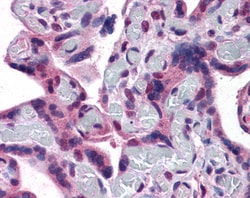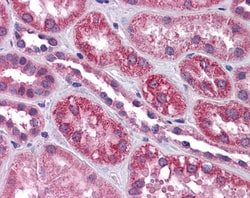Promotional price valid on web orders only. Your contract pricing may differ. Interested in signing up for a dedicated account number?
Learn More
Learn More
Invitrogen™ TRPC4 Polyclonal Antibody
Goat Polyclonal Antibody
Supplier: Invitrogen™ PA518987
Description
This antibody is predicted to react with bovine, canine, human, mouse and porcine based on sequence homology. This antibody is tested in Peptide ELISA: antibody detection limit dilution 32,000.
TRPC4 is a member of the canonical subfamily of transient receptor potential cation channels. TRPC4 forms a non-selective calcium-permeable cation channel that is activated by Gq-coupled receptors and tyrosine kinases, and plays a role in multiple processes including endothelial permeability, vasodilation, neurotransmitter release and cell proliferation. Single nucleotide polymorphisms in TRPC4 may be associated with generalized epilepsy with photosensitivity. Alternatively spliced transcript variants encoding multiple isoforms have been observed for TRPC4. The classical or canonical transient receptor potential (TRPC) channels are the subfamily most closely related to the founding member of the TRP family, the Drosophila TRP channel. TRPC channels have seven TRPC genes that encode the channel protein (TRPC1-7). Diseases associated with TRPC4 include Photosensitive Epilepsy.CaV3.3 encodes the pore-forming alpha subunit of a voltage gated calcium channel. The encoded protein is a member of a subfamily of calcium channels referred to as is a low voltage-activated, T-type, calcium channel. The channel encoded by CaV3.3 is characterized by a slower activation and inactivation compared to other T-type calcium channels. CaV3.3 may be involved in calcium signaling in neurons. Alternate splicing results in multiple transcript variants of CaV3.3. Voltage-gated calcium channels (CaV) are present in the membrane of most excitable cells and mediate calcium influx in response to depolarization, an proteins such as CaV3.3 regulate intracellular processes such as contraction, secretion, neurotransmission and gene expression. Diseases associated with CACNA1I include Childhood Absence Epilepsy.
Specifications
| TRPC4 | |
| Polyclonal | |
| Unconjugated | |
| Trpc4 | |
| alpha TRPC4; beta TRPC4; beta-2 TRPC4; capacitative calcium entry channel 1; capacitative calcium entry channel Trp4; CCE1; HTRP4; HTRP-4; MGC119570; MGC119571; MGC119572; MGC119573; putative capacitative calcium entry channel; receptor-activated cation channel TRP4; Short transient receptor potential channel 4; STRPC4; transient receptor potential cation channel subfamily C member 4; transient receptor potential cation channel, subfamily C, member 4; transient receptor potential channel 4; transient receptor potential protein 4; transient receptor protein 4; Trp4; TRPC 4; Trpc4; Trpc4_v2; trp-related protein 4; Trrp4 | |
| Goat | |
| Ammonium Sulfate Precipitation | |
| RUO | |
| 22066, 7223, 84494 | |
| -20°C, Avoid Freeze/Thaw Cycles | |
| Liquid |
| Immunohistochemistry (Paraffin), Western Blot | |
| 0.5 mg/mL | |
| TBS with 0.5% BSA and 0.02% sodium azide; pH 7.3 | |
| O35119, Q9QUQ5, Q9UBN4 | |
| Trpc4 | |
| Synthetic peptide sequence (KHAKEEDSSIDYD) corresponding to the internal amino acids of TRPC4 (aa 948-960). | |
| 100 μg | |
| Primary | |
| Human, Mouse, Rat | |
| Antibody | |
| IgG |
Safety and Handling
WARNING: Cancer - www.P65Warnings.ca.gov
Product Content Correction
Your input is important to us. Please complete this form to provide feedback related to the content on this product.
Product Title
Spot an opportunity for improvement?Share a Content Correction


